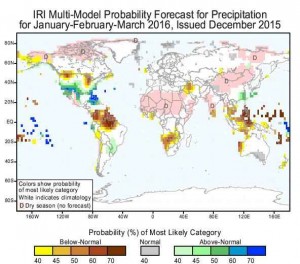Snow in the mountains winter 2015-16
By Michael FaginSnow MountainsSnow in the mountains winter 2015-16 is, at large, deeper than popularly predicted. As of Jan. 16th 2015, the Alaskan snow in the mountains (snowpack) is at 191% of its historical mean. In the contiguous states, California has 132%, Colorado has 105%, Washington has 102%, Oregon and Utah have 120%, and Idaho and Montana have 80%. The particularly heightened totals for California and Alaska are due to increased precipitation from the Pacific Ocean under the influence of El Niño. So given the drought from this summer snow in the mountains for the Western US for the winter of 2015-16 is off to a good start as we are getting plenty of snow in the mountains.
The Climate Prediction Center missed its mark with Washington and Oregon in its November-January outlook when it predicted both below average precipitation for a patch centered on the Rockies of Montana and higher temperatures, especially near the West Coast.
Looking abroad, there was only 60-90% in the Alps after experiencing a dry December, which became the region’s hottest since 1864. About a foot of snow in the mountains fell a couple weeks into winter 2015-16. In some areas, the avalanche danger index has consequently risen to 4 out of 5.
Winter 2016 Outlooks
The International Research Institute for Climatology and Society’s precipitation forecast is predicting below normal snowfall for the Alaska Range for January through March of 2016. Also below normal snowfall for Washington, Oregon, Idaho and Montana for January through March. Much of California, Utah and Colorado should continue to have above normal snow for January through March.
The Himalayas are projected to endure nearly typical conditions for the January through March period. However it is important to note that the winter and early spring data carries little relevance for much of Asia because 80% of its annual precipitation arrives between June and September.

IRI forecast for Jan. to March 2016
Written by Meteorologist Geoff Linsley
